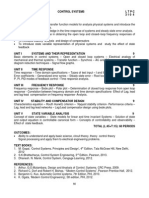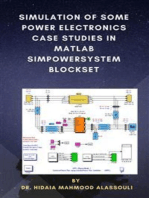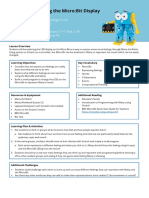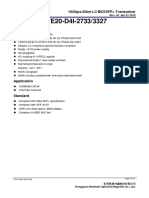Govt. College of Engineering & Technology
Govt. College of Engineering & Technology
Uploaded by
sunil singhCopyright:
Available Formats
Govt. College of Engineering & Technology
Govt. College of Engineering & Technology
Uploaded by
sunil singhOriginal Description:
Original Title
Copyright
Available Formats
Share this document
Did you find this document useful?
Is this content inappropriate?
Copyright:
Available Formats
Govt. College of Engineering & Technology
Govt. College of Engineering & Technology
Uploaded by
sunil singhCopyright:
Available Formats
GOVT.
COLLEGE OF ENGINEERING & TECHNOLOGY
CLASS: B.E. 4TH SEMESTER Hours/ Week Marks Distribution
BRANCH: ELECTRICAL ENGINEERING
L T P Theory Sessional
COURSE CODE: EE-402
TITLE: CONTROL SYSTEMS-1 3 2 0 100 40
DURATION OF EXAM: 3 HOURS
SECTION-I
Introduction to Linear Control System: Control Systems, types of control systems, feedback and its
effects, mathematical modeling of physical systems.
System Representation: Block diagrams, representation of control systems, transfer functions, signal
flow graphs, polar and Bode plot representation of loop gains of control systems.
Time Domain Analysis of Control Systems: Time domain analysis of first & 2nd order Control systems.
Typical test signals for time response of control systems, time domain performance of first and second
order control systems (steady state response and transient response).
Design of Feedback Control Systems: Approaches to system design, phase lead, and phase lag
design using Bode-diagram and root locus techniques. Introduction to P,PI and PID controllers Polar
Plot.
SECTION-II
Analysis of Linear Feedback Systems : Stability characteristic equation, stability of linear time
invariant systems, Routh-Hurwitz stability Criterion, Root locus plot, Bode plot, Polar Plot, Niquest
Criterion.
Frequency Domain Analysis of Control Systems: Frequency domain characteristics second order
systems relative stability, graphic methods of determining gain margin and phase margin, Nicholas
chart.
Control Components: General block diagram of a control system, a.c. and d.c. Servomotors, a.c.
tachometer, synchro transmitter and receiver, synchro pair as control transformer, a.c and d.c position
control system, stepper motor. magnetic amplifier.
RECOMMENDED BOOKS:
1. Modern Control Engineering K.Ogatta
2. Automatic Control Systems B.C. Kuo
3. Control System Engineering Nagrath and Gopal
NOTE : There shall be total eight questions, four from each section. Five questions have to be
attempted selecting at least two questions from each section. Use of calculator and semi log
graph are allowed.
36 SYLLABUS FOR ELECTRICAL ENGG.
You might also like
- Syllabus Control Systems ECE R13Document2 pagesSyllabus Control Systems ECE R13tansnvarmaNo ratings yet
- Jntuk Eee 4-2 Sem Syllabus Book (R10)Document23 pagesJntuk Eee 4-2 Sem Syllabus Book (R10)Venkat KickNo ratings yet
- Eee.60-62Document3 pagesEee.60-62skrtamilNo ratings yet
- Optimal Control: Linear Quadratic MethodsFrom EverandOptimal Control: Linear Quadratic MethodsRating: 4 out of 5 stars4/5 (2)
- FPSC Assistant Executive Engineer (Electrical) Test: ElectronicsDocument7 pagesFPSC Assistant Executive Engineer (Electrical) Test: ElectronicsOwaisKhan100% (2)
- Syllabus 5th SemDocument21 pagesSyllabus 5th SemAmit SahuNo ratings yet
- Ymca College 5 Sem Btech ElectricalDocument12 pagesYmca College 5 Sem Btech Electricalvinit kumarNo ratings yet
- SallyubusDocument61 pagesSallyubusravindra898233No ratings yet
- Department of Electrical Engineering: M.Tech. ProgramsDocument17 pagesDepartment of Electrical Engineering: M.Tech. ProgramsSidali ChaibNo ratings yet
- CS Basic1Document12 pagesCS Basic1mansoorNo ratings yet
- 4 THDocument10 pages4 THYuv RajNo ratings yet
- Cs Subject MaterialDocument125 pagesCs Subject MaterialAjay KumarNo ratings yet
- Control SystemsDocument2 pagesControl SystemsAbhishek KumarNo ratings yet
- CS 3-1Document2 pagesCS 3-1Uggina Narisinga RaoNo ratings yet
- Control Systems NotesDocument74 pagesControl Systems NotesNirjal RanipaNo ratings yet
- 6th Sem EEE 18Document28 pages6th Sem EEE 18Iqbal Ahammed KaladgikarNo ratings yet
- M.E. (Power System Engineering)Document38 pagesM.E. (Power System Engineering)Vetrivel GobiNo ratings yet
- Syllabus of OpjuDocument16 pagesSyllabus of OpjutarunNo ratings yet
- Control Systems 1Document130 pagesControl Systems 1ndunguian66No ratings yet
- Control+system Lesson+planDocument6 pagesControl+system Lesson+planNarasimman DonNo ratings yet
- Control Systems PDFDocument133 pagesControl Systems PDFShaboddinNo ratings yet
- Final Year BTech Electronics Syllabus 2022-23Document48 pagesFinal Year BTech Electronics Syllabus 2022-23SiddhantNo ratings yet
- EE484 Control SystemsDocument2 pagesEE484 Control Systemssaheedahmd0112No ratings yet
- Ece IV Control Systems (10es43) Notes - 3Document208 pagesEce IV Control Systems (10es43) Notes - 3pallaviteraniNo ratings yet
- ME Drives and Control SyllabusDocument34 pagesME Drives and Control SyllabusHarshal VaidyaNo ratings yet
- Control Systems NotesDocument125 pagesControl Systems Notessandra ambicaNo ratings yet
- Control Systems 1Document2 pagesControl Systems 1wasai mwendaNo ratings yet
- Electrical and Electronics Engg. B.Tech. Semester-Vii: Course Code Course Title L T P CreditsDocument26 pagesElectrical and Electronics Engg. B.Tech. Semester-Vii: Course Code Course Title L T P CreditsAbhishek Kumar ChambelNo ratings yet
- B.tech (EE) 5th & 6th SemDocument23 pagesB.tech (EE) 5th & 6th SemAdan HoodaNo ratings yet
- Control System Lecture PlanDocument3 pagesControl System Lecture PlanGulzar AhamdNo ratings yet
- Chhattisgarh Swami Vivekanand Technical University, BhilaiDocument25 pagesChhattisgarh Swami Vivekanand Technical University, BhilaiPiyush KumarNo ratings yet
- EED M.tech SyllabusDocument28 pagesEED M.tech SyllabusAthiesh Kumar100% (1)
- BE Applied Electronics and InstrumentationDocument104 pagesBE Applied Electronics and InstrumentationEr Paramjit SinghNo ratings yet
- Control Unit 1Document37 pagesControl Unit 1AnshNo ratings yet
- Feedback Control System SyllabusDocument3 pagesFeedback Control System SyllabusDamanMakhijaNo ratings yet
- Control EngineeringDocument1 pageControl Engineeringaxatpgme100% (1)
- Sastra Universiy: B.Tech (Eee) ProgrammeDocument13 pagesSastra Universiy: B.Tech (Eee) ProgrammeSriram VenkatachariNo ratings yet
- M.tech 2ND Sem SyllabusDocument6 pagesM.tech 2ND Sem SyllabusraghuNo ratings yet
- Control System - Lesson PlanDocument7 pagesControl System - Lesson PlanNarasimman DonNo ratings yet
- Power Electronics and DrivesDocument34 pagesPower Electronics and Drivespraveenr5883No ratings yet
- Control Systems NotesDocument133 pagesControl Systems Noteseee limatNo ratings yet
- Ece IV Control Systems (10es43) Notes1Document205 pagesEce IV Control Systems (10es43) Notes1Nithindev GuttikondaNo ratings yet
- B.Tech, EE, 5th Sem, 2018-19 BatchDocument19 pagesB.Tech, EE, 5th Sem, 2018-19 BatchBijayKumarDasNo ratings yet
- Syllabus of CONTROL SYSTEMS EEC502Document1 pageSyllabus of CONTROL SYSTEMS EEC502toved43853No ratings yet
- Mechatronics CoursesDocument6 pagesMechatronics CoursesVivek JhaNo ratings yet
- JNTUA Control Systems Notes - R20Document126 pagesJNTUA Control Systems Notes - R20crezyshorts401No ratings yet
- Chhattisgarh Swami Vivekanand Technical University, Bhilai: Total Period 08Document19 pagesChhattisgarh Swami Vivekanand Technical University, Bhilai: Total Period 08Piyush KumarNo ratings yet
- Control EngineeringDocument2 pagesControl EngineeringPradip PatelNo ratings yet
- Electrical & Electonics Engg III SemDocument13 pagesElectrical & Electonics Engg III Semsuperbs1001100% (1)
- Course Name: CONTROL SYSTEM I Course Code: EE 503 Credit: 4: To Understand This Course, The Student Must Have Idea ofDocument6 pagesCourse Name: CONTROL SYSTEM I Course Code: EE 503 Credit: 4: To Understand This Course, The Student Must Have Idea ofmanish_iitrNo ratings yet
- MEEID Industrial Drives and Control PDFDocument19 pagesMEEID Industrial Drives and Control PDFAhmed58seribegawanNo ratings yet
- Control SystemDocument359 pagesControl SystemAwadhesh VermaNo ratings yet
- Control Systems Engineering: 2 MarksDocument24 pagesControl Systems Engineering: 2 MarksDhivyaManian75% (4)
- Control SystemsDocument134 pagesControl Systemsdes tos100% (1)
- Control Systems Engineering 2 MarksDocument30 pagesControl Systems Engineering 2 MarksomprakashabbavaramNo ratings yet
- Simulation of Some Power System, Control System and Power Electronics Case Studies Using Matlab and PowerWorld SimulatorFrom EverandSimulation of Some Power System, Control System and Power Electronics Case Studies Using Matlab and PowerWorld SimulatorNo ratings yet
- Advanced Control of AC / DC Power Networks: System of Systems Approach Based on Spatio-temporal ScalesFrom EverandAdvanced Control of AC / DC Power Networks: System of Systems Approach Based on Spatio-temporal ScalesNo ratings yet
- Protection of Substation Critical Equipment Against Intentional Electromagnetic ThreatsFrom EverandProtection of Substation Critical Equipment Against Intentional Electromagnetic ThreatsNo ratings yet
- Simulation of Some Power Electronics Case Studies in Matlab Simpowersystem BlocksetFrom EverandSimulation of Some Power Electronics Case Studies in Matlab Simpowersystem BlocksetNo ratings yet
- Simulation of Some Power Electronics Case Studies in Matlab Simpowersystem BlocksetFrom EverandSimulation of Some Power Electronics Case Studies in Matlab Simpowersystem BlocksetNo ratings yet
- NEHA CHIB Presentation On ROLE OF TEACHER IN FICILITATING EMOTIONAL DEVELOPMENTDocument12 pagesNEHA CHIB Presentation On ROLE OF TEACHER IN FICILITATING EMOTIONAL DEVELOPMENTsunil singhNo ratings yet
- Name Born Nationality Career Died: Anton Pavlovich ChekhovDocument9 pagesName Born Nationality Career Died: Anton Pavlovich Chekhovsunil singh100% (1)
- Analog Electronics 4 PDFDocument1 pageAnalog Electronics 4 PDFsunil singhNo ratings yet
- Govt. College of Engineering & TechnologyDocument1 pageGovt. College of Engineering & Technologysunil singhNo ratings yet
- Uee UsesDocument4 pagesUee Usessunil singhNo ratings yet
- Govt. College of Engineering & TechnologyDocument1 pageGovt. College of Engineering & Technologysunil singhNo ratings yet
- Braking PDFDocument8 pagesBraking PDFsunil singhNo ratings yet
- Energy Tapping Identifier Through Wireless Data AcquisitionDocument4 pagesEnergy Tapping Identifier Through Wireless Data Acquisitionsunil singhNo ratings yet
- A Stable Radio Microphone With Loop AntennaDocument2 pagesA Stable Radio Microphone With Loop AntennaDevadas100% (1)
- Videoscope Iris XT LeafletDocument5 pagesVideoscope Iris XT Leaflettarariquetevi2No ratings yet
- Brother TD 4100NDocument139 pagesBrother TD 4100NSertecNo ratings yet
- WW Esdr4 PDFDocument4 pagesWW Esdr4 PDFAung MhNo ratings yet
- Manual - Driver INDEL1Document12 pagesManual - Driver INDEL1Marcelo LescanoNo ratings yet
- M ,.JVVDocument17 pagesM ,.JVVVitorio LogoNo ratings yet
- A510 Manual EN V03Document434 pagesA510 Manual EN V03willian bernardoNo ratings yet
- 06547335Document7 pages06547335Christos Apostolopoulos100% (1)
- Ringmaster Range Indoor Outdoor Switchgear v7 - 2001Document48 pagesRingmaster Range Indoor Outdoor Switchgear v7 - 2001322399mk70860% (1)
- Big Blue 300 D PRO 300 D: OM-236 949A ProcessesDocument74 pagesBig Blue 300 D PRO 300 D: OM-236 949A ProcessesFrederikusNo ratings yet
- Lesson 1.20 - Using The Micro:Bit DisplayDocument3 pagesLesson 1.20 - Using The Micro:Bit DisplayBuzatu GianiNo ratings yet
- Mira Visibility Sensor 3544 3544 EXDocument2 pagesMira Visibility Sensor 3544 3544 EXMed MohNo ratings yet
- Relays, TimersDocument25 pagesRelays, TimersDavid LucioNo ratings yet
- Ax350i Spec enDocument2 pagesAx350i Spec enFranz Castro50% (2)
- Product Brochure - Solutions For EV Charging Systems Sell Sheet - PB3110Document2 pagesProduct Brochure - Solutions For EV Charging Systems Sell Sheet - PB3110Alvin NgNo ratings yet
- Gefran 600 Pidcontroler Manual PDFDocument30 pagesGefran 600 Pidcontroler Manual PDFDeivis Javier Conrado OrtegaNo ratings yet
- Dell Mini 10 - Compal La-5091p Kiu20 - Rev 1.0secDocument39 pagesDell Mini 10 - Compal La-5091p Kiu20 - Rev 1.0secChris ParryNo ratings yet
- ET Series Pro2.0 GB V1.0Document23 pagesET Series Pro2.0 GB V1.0Victor PATIÑONo ratings yet
- Emc Symmetrix Vmax SeriesDocument32 pagesEmc Symmetrix Vmax SeriesMadhavi LataNo ratings yet
- SCR-Based ESD Protection Designs For RF ICsDocument3 pagesSCR-Based ESD Protection Designs For RF ICsjournalNo ratings yet
- HBX 3319DS VTM PDFDocument3 pagesHBX 3319DS VTM PDFcesarbayonaNo ratings yet
- 10Gbps 20km LC BIDI SFP+ TransceiverDocument11 pages10Gbps 20km LC BIDI SFP+ TransceiverrauolNo ratings yet
- Thermal Management of A Lithium Ion Battery Module Using A Thermoelectric Cooler With Stirling Engine Heat Pump 1Document55 pagesThermal Management of A Lithium Ion Battery Module Using A Thermoelectric Cooler With Stirling Engine Heat Pump 1Joshua Roberto GrutaNo ratings yet
- A Study of Wireless Networks: Wlans, Wpans, Wmans, and Wwans With ComparisonDocument4 pagesA Study of Wireless Networks: Wlans, Wpans, Wmans, and Wwans With ComparisonWissem HammoudaNo ratings yet
- World University of Bangladesh: Lab Report - Week-2 - Fall Semester 2020Document10 pagesWorld University of Bangladesh: Lab Report - Week-2 - Fall Semester 2020Aroni RahmanNo ratings yet
- Mindray DigiEye 280Document4 pagesMindray DigiEye 280irwin kurniadiNo ratings yet
- IPROG 1engDocument14 pagesIPROG 1engعبد المولى المجاهدNo ratings yet
- F-r100 Industrial Router Technical Specification v1.0.0Document3 pagesF-r100 Industrial Router Technical Specification v1.0.0Xiamen Four-Faith Industrial Router supplierNo ratings yet
- OPTOELEKTRONIKADocument4 pagesOPTOELEKTRONIKAkenan halilcevicNo ratings yet

































































































